Chapter 3: Improving our current services
Updated 30 July 2021
Applies to England, Scotland and Wales
This is a summary of analysis to support Chapter 3 of Shaping Future Support: The Health and Disability Green Paper. The publication covers information on working age health and disability benefits in Great Britain.
This includes:
- satisfaction with DWP services
- support for people with terminal illnesses
- the transition between Child DLA and PIP
- satisfaction with the Work Capability Assessment and PIP Assessment process
- independent audits of Work Capability Assessments and PIP Assessments
- evidence of the benefits of a single assessment to replace the Work Capability Assessment and PIP Assessment
- the proportion of Work Capability Assessments and PIP Assessments that are carried out face-to-face
- satisfaction of people assessed via telephone assessment during the coronavirus pandemic
- the severe conditions criteria on Work Capability Assessments
- changes of award when assessments are held to review people’s level of support
- the impact of a different approach to decision making
What you need to know
The data in this evidence pack comes from a range of sources that are referenced in the accompanying data tables. The new data presented here includes analysis from:
- 100% DWP administrative data of people receiving
- Employment and Support Allowance (ESA)
- Universal Credit (UC)
- Disability Living Allowance (DLA)
- Personal Independence Payment (PIP)
- 100% DWP administrative data of Work Capability Assessments and PIP assessments, mandatory reconsiderations (MRs) and appeals
- 100% DWP administrative data of people attending employment programmes
- 100% HMRC administrative data of P14 and P45 records of people receiving DWP benefits.
- DWP Benefit Caseload and Expenditure Outturn and Forecasts
- DWP commissioned research reports
- other research reports
- survey data
Data tables, which provide more details on the data and analysis presented here, are available online.
1. Main stories
The statistics show:
- overall satisfaction is lower for health and disability benefits than for other DWP benefits
- ESA and PIP are applied for by approximately 2,000 people a month who report a Terminal Illness
- an average of 3,000 people each month who received child DLA are assessed for PIP
- over 90% of people attending PIP assessments and WCAs report being satisfied with the process
- over 90% of PIP assessment and WCA reports are judged as acceptable by Independent Audits
- evidence suggests a combined WCA and PIP assessment would not improve DWP customer experience
- where there is clear evidence to recommend ESA or PIP awards, there is no face-to-face assessment.
- the majority of people assessed via telephone during the coronavirus pandemic were satisfied
- the Severe Conditions criteria have led to 120,000 people on ESA no longer needing routine repeat WCAs
- award reviews or repeat assessments lead to increases and decreases in benefit entitlement
- DWP is taking a different approach to making decisions to try and improve Decision Making
2. Overall satisfaction is lower for health and disability benefits than for other DWP benefits
Claimants who were satisfied overall, by benefit type
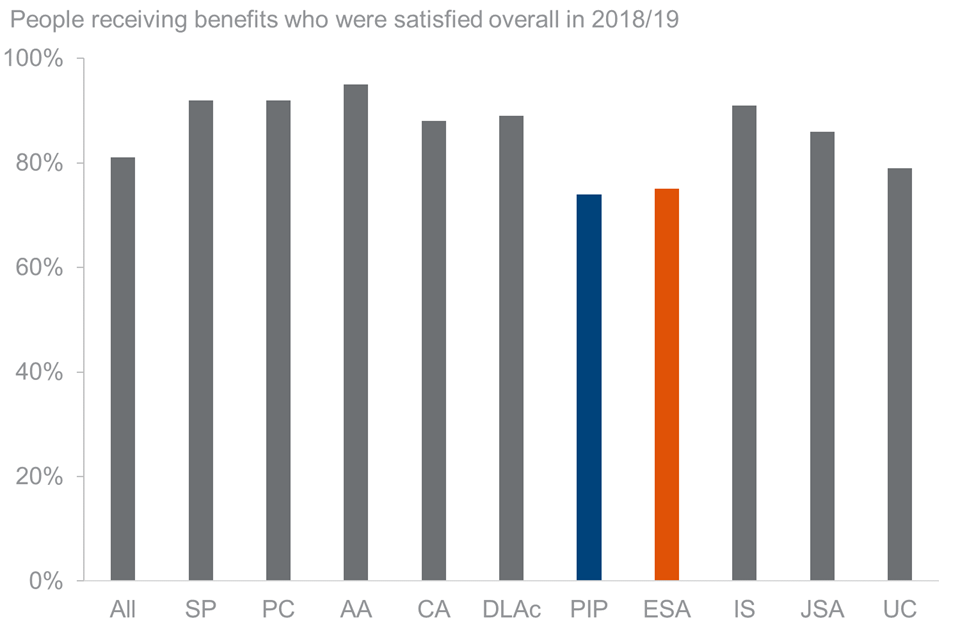
Source: DWP claimant and experience survey 2018 to 2019
Overall satisfaction for PIP, ESA and UC is lower than for other benefits.
Overall over 80% of people interacting with DWP are satisfied overall.
The proportion of people satisfied overall with PIP (74%), ESA (75%) and UC (79%) is lower than for other DWP benefits, and lower than the proportion of people satisfied overall.
Claimants who were satisfied with their latest transaction, by benefit type
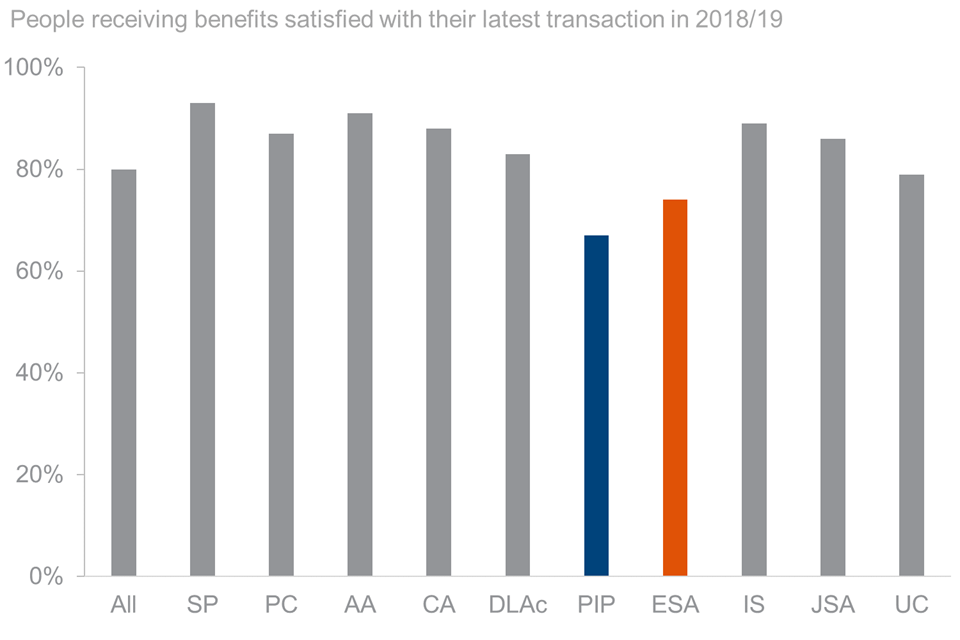
Source: DWP claimant and experience survey 2018 to 2019
Satisfaction with DWP’s handling of their transaction for PIP, ESA and UC is lower than for other benefits.
The term transaction as used above refers to the specific transaction that the person reported having with the DWP within the last three months. This could include:
- making a new claim for a benefit
- reporting a change of circumstances
- attending a review meeting at a Jobcentre
3. Thousands of working age people each month are supported near the end of their lives by Special Rules for Terminal Illness on DWP benefits
People awarded the ESA Support Group because of a terminal illness.

Source: Stat-Xplore
Since its introduction in 2008 until March 2019, ESA made an average of 500 Support Group awards a month owing to Terminal Illness.
Employment and Support Allowance (ESA) can be claimed where a person has a disability or health condition that affects how much they can work.
If someone is living with a terminal illness and their doctor or a medical professional has said they might have less than 6 months to live, they may get benefits at a higher rate or get extra money, and start getting payments quicker than usual
This is sometimes called ‘special rules’.
Following the introduction of ESA in 2008 and until 2017 when people with terminal illnesses could make claims to Universal Credit (UC), the number of people awarded the ESA Support Group because of a terminal illness has fluctuated around an average of 500 people a month.
PIP terminal illness registrations
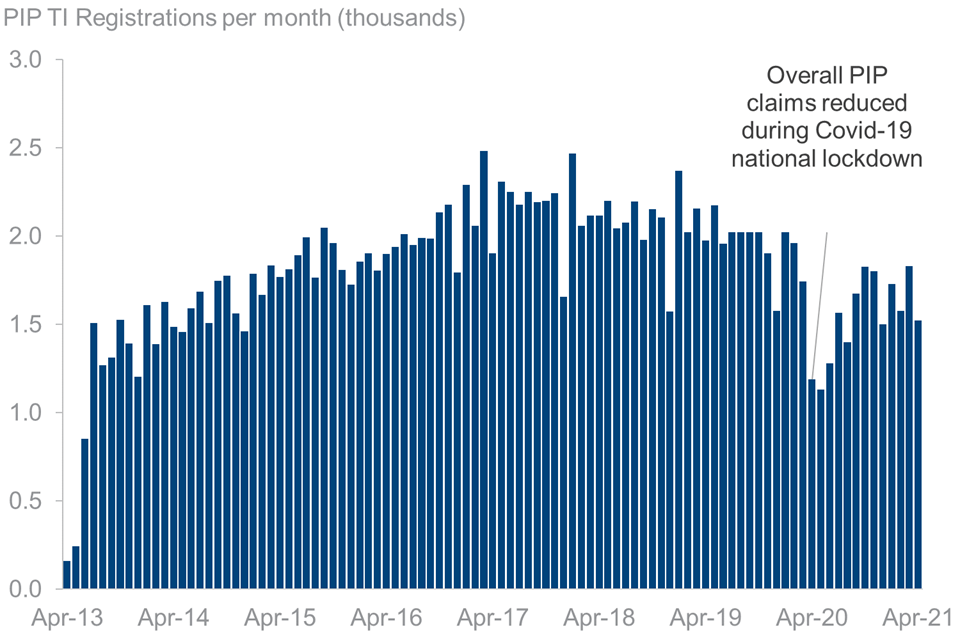
Source: Stat-Xplore
Since its introduction in 2013, PIP has received an average of 1,800 Terminal Illness Registrations a month.
PIP can help with some of the extra costs if you have ill-health or a disability. It can be claimed by people even if their condition does not affect how much they can work. Therefore, more people with a terminal illness register a claim for PIP than for ESA.
You can get PIP more quickly if you are terminally ill. You can claim PIP if your doctor or a medical professional has said you might have less than 6 months to live.
The number of people that register a claim to PIP and report a terminal illness fluctuates each month. This is a combination of people that self-identified as having a terminal illness when they registered their claim and people who were identified as terminally ill during the processing of the claim.
The fall in registration seen in April 2020 is due to the overall reduction in PIP registrations during the coronavirus pandemic national lockdown.
4. An average of 3,000 people each month who received child DLA are assessed for PIP
Child DLA to PIP claims from April 2013 to October 2020.
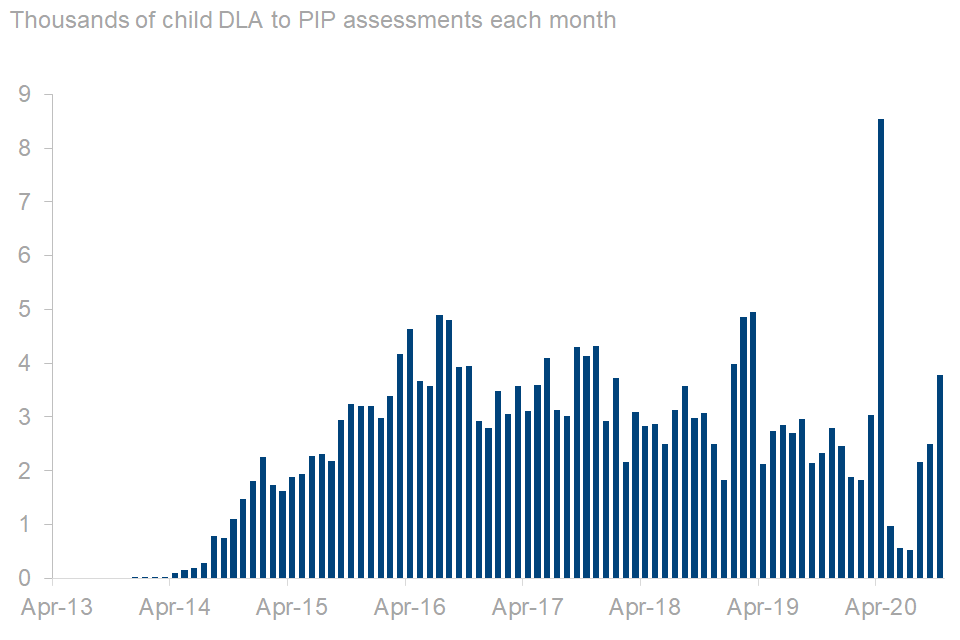
Source: Stat-Xplore
To October 2020, there have been a total of 221,000 people who received child DLA who have been assessed for PIP.
When a child that is in receipt of DLA approaches their 16th birthday they are contacted by DWP to invite them to claim PIP before their DLA claim comes to an end.
The number of child DLA to PIP claims, fluctuates between 2,000 and 5,000 each month.
There were unusual peaks and dips in child DLA reassessments during 2020 owing to the coronavirus pandemic. The fall seen in the claims from April 2020 is due to the coronavirus pandemic national lockdown and the introduction of a pause in the child DLA to PIP invitation process.
Child DLA to PIP reassessments which resulted in a disallowed, reduced, unchanged or an increased PIP award.
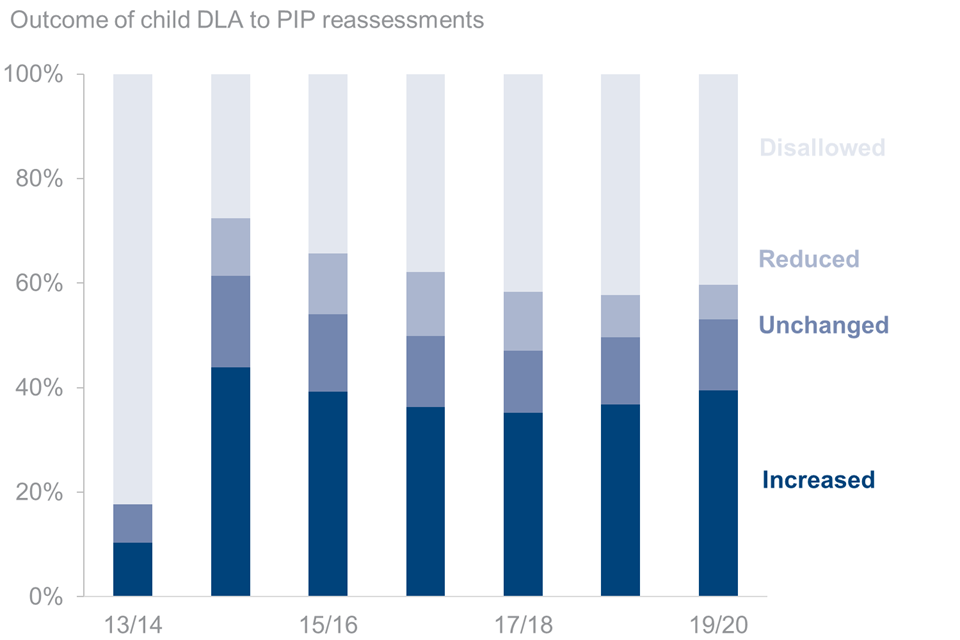
Source: Stat-Xplore
Assessments of people receiving child DLA for PIP increased benefit awards in 53% of cases in 2019 to 2020.
There are 11 possible rates of award on DLA and 8 possible rates of award on PIP. At a DLA to PIP reassessment people can either be awarded a higher or lower amount, or be disallowed PIP.
In 2017 to 2018 47% of people reassessed from child DLA received the same or an increased PIP award. The proportion receiving the same or an increased PIP award has increased since then to 53% of people in 2019 to 2020.
5. Over 90% of people attending PIP assessments and WCAs report being satisfied with the process
The percentage of people attending WCAs who reported being satisfied with the process.
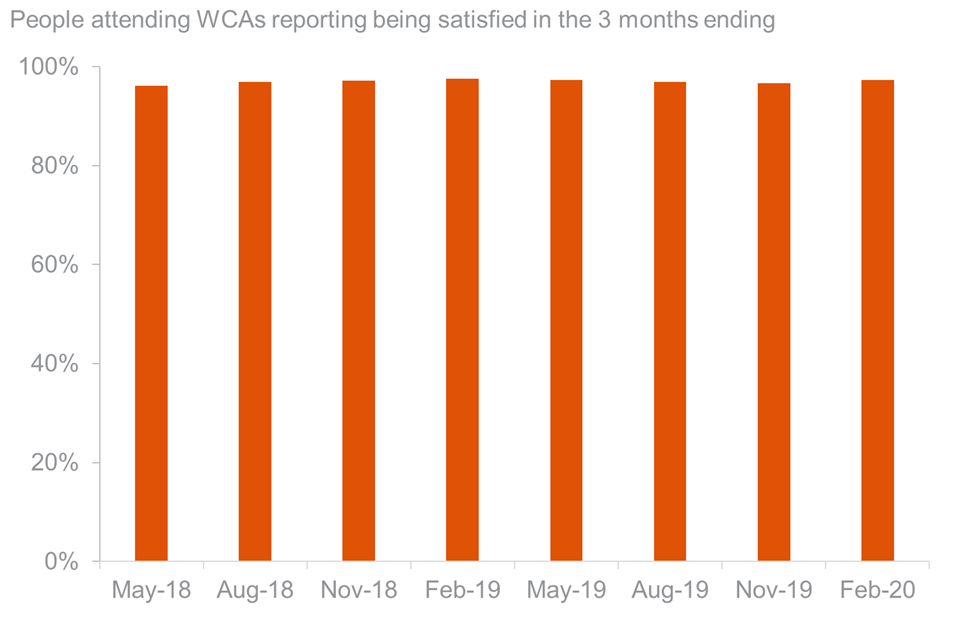
Source: Shaping Future Support Green Paper evidence pack
Between March 2018 and February 2020, an average of 97% of people who had a WCA were satisfied with the process.
On average between March 2018 and February 2020, 97% of people who had a work capability assessment were satisfied with the process. This is based on an independent survey of a random sample of over 1,000 individuals each quarter.
Each quarter, the WCA assessment provider commissions an independent research company to survey a random selection of people who have attended a WCA on the quality of service they receive. This helps them provide a high quality, sensitive and respectful service for everyone assessed.
People are asked questions on their appointment arrangements, the facilities at the Assessment Centres and how they feel about how the Healthcare Professional interacted with them.
The percentage of people attending a PIP assessment who reported being satisfied with the process.

Source: Shaping Future Support Green Paper evidence pack
Between March 2018 and February 2020, an average of 94% of people who had a PIP assessment were satisfied with the process.
On average between March 2018 and February 2020, 94% of people who had a PIP assessment were satisfied with the process. This is based on a similar survey of a random sample of individuals attending a PIP assessment, and is the average satisfaction score of the two PIP assessment providers.
When people attend PIP assessments, the assessment provider might ask them to complete a satisfaction survey to hear views on how they have done. This helps make the service better.
6. Over 90% of PIP assessment and WCA reports are judged as acceptable by Independent Audits
The percentage of Work Capability Assessment reports which met the required standard
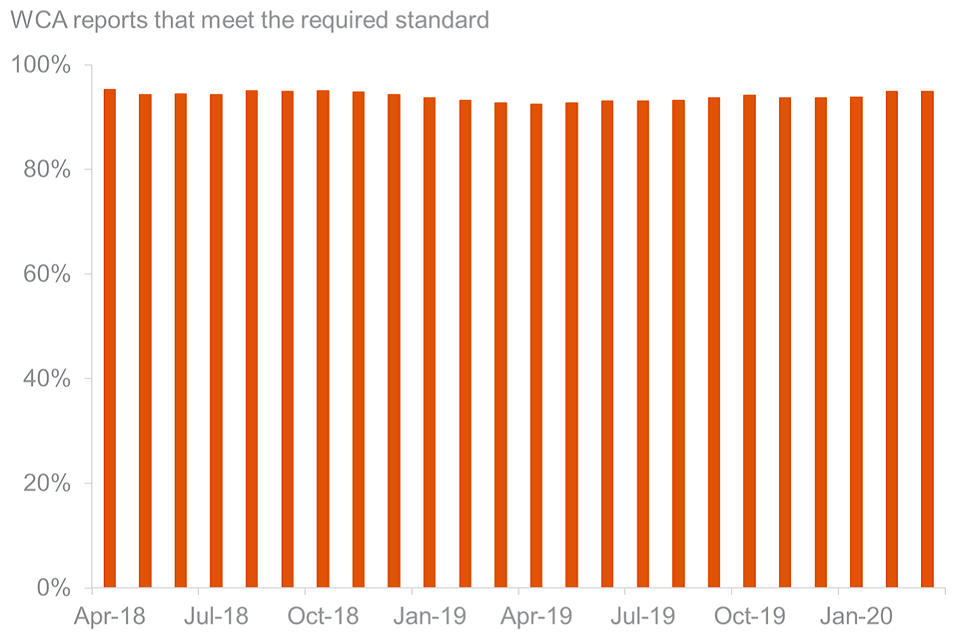
Source: Shaping Future Support Green Paper evidence pack
Between April 2018 and March 2020, an average of 94% WCA reports met the required standards in Independent Audits.
DWP robustly monitors the performance of the WCA provider. Every month a random sample of assessment reports are independently audited to ensure that the advice provided to the Department’s decision makers is of suitable quality, fully explained, and justified. These assessment reports are used to inform DWP decisions on ESA and UC*. Reports deemed unacceptable are returned to Centre for Health and Disability Assessment (CHDA) for reworking.
Assessment reports are graded as A, B or C against the following areas:
- Presentation and Process
- Medical Examination
- Medical Reasoning
- Professional Issues
An A or B grade indicates that the key requirements are satisfied, while a C grade indicates that key requirements are not satisfied and the report fails to meet the required standard.
Between April 2018 and March 2020 an average of 94% of WCA reports were judged as A or B grades in Independent Audits.
The Department continues to work extensively with the assessment provider to make improvements to guidance, training and audit procedures in order to ensure that a quality service is maintained.
The percentage of PIP assessment reports which were judged acceptable

Source: Shaping Future Support Green Paper evidence pack
Between April 2018 and March 2020, an average of 96% PIP reports were judged as acceptable by Independent Audits.
The performance of the PIP assessment providers is monitored by an Independent Audit process of the assessment reports produced by the providers. Every month a random sample of assessments reports are independently audited. The reports are used to inform DWP decisions on PIP entitlement.
Since March 2016, PIP assessment reports have been audited in four areas:
- Opinion
- Information Gathering
- Further Evidence
- Process
Reports are graded as:
- Acceptable
- Acceptable Healthcare Professional Learning Required
- Acceptable Report Amendment Required
- Unacceptable
Between April 2018 and March 2020 an average of 96% of PIP reports were judged as acceptable by Independent Audits. This is an average percentage of assessments reports judged as acceptable from Independent Audits of assessment reports from both PIP assessment providers.
7. Evidence suggests a combined single WCA and PIP assessment would not improve disabled people’s experience without wider transformation or reform
The proportion of people who have both an WCA and PIP assessment within a 3-month period.
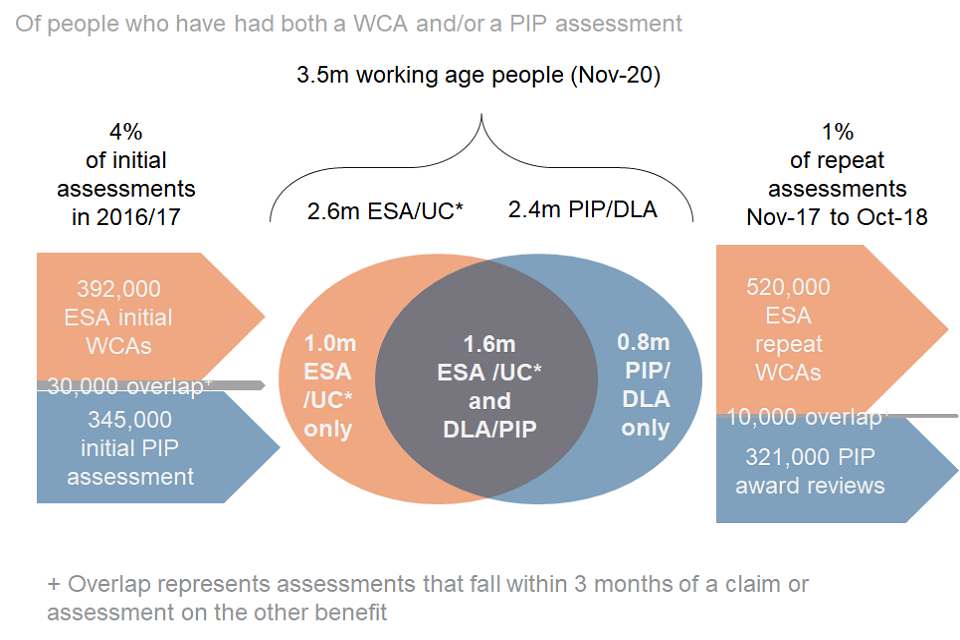
Source: Stat-Xplore, Personal Independence Payment statistics to January 2021 and Shaping Future Support Green Paper evidence pack
Only a small proportion of WCA and PIP assessments for ESA/UC or PIP occur within 3 months of a claim or an assessment for the other benefit.
Currently people are assessed separately for PIP and ESA/UC* using two different assessments, the PIP assessment and the WCA.
Whilst 1.6 million people receive both ESA/UC* and PIP/DLA at the same time, only a small proportion of people who have had both a WCA and a PIP assessment had these within 3 months of each other.
In 2016 to 2017, 4% of the total number of PIP initial assessments and initial ESA WCAs in 2016 to 2017 occurred within 3 months of a claim for the other benefit.
Between November 2017 and October 2018, 1% of all PIP award reviews and ESA repeat WCAs occurred within 3 months.
People who have both a repeat ESA and PIP award review within a 3-month period.
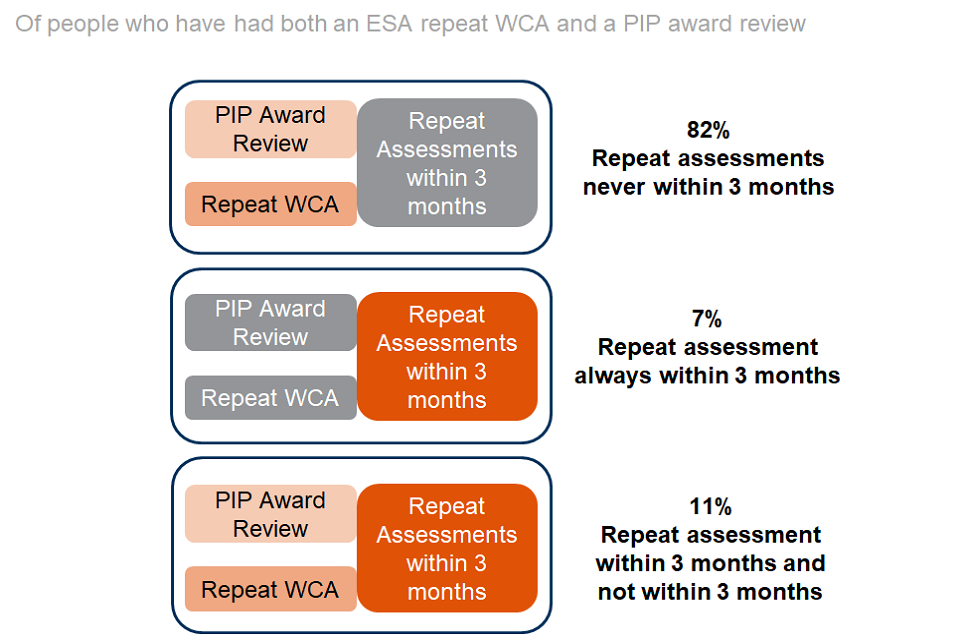
Source: Stat-Xplore, Personal Independence Payment statistics to January 2021 and Shaping Future Support Green Paper evidence pack
A single assessment could mean some people having to attend a third type of assessment alongside a repeat WCA and a PIP award review.
82% of people who have had both an ESA repeat WCA and a PIP award review have never had these two assessments within 3 months of each other.
7% of people who have had both an ESA repeat WCA and a PIP award review have always had these two assessments within 3 months of each other.
The remaining 11% of people who have had both an ESA repeat WCA and a PIP award review have had these two assessments within 3 months of each other, but have also had another ESA repeat WCA and/or PIP award review not within 3 months of each other.
Reasons claims and assessments for ESA and PIP are at different times include; income-related ESA can depend on your household income and savings, while PIP does not depend on this; ESA can provide support if a health condition or disability affects how much you can work, while PIP can be claimed by anyone who needs help with the extra costs of a long term health condition or disability; ESA can be claimed as soon as your health condition or disability affects how much you can to work, while PIP requires you to have had difficulty with daily living or getting around for 3 months and expect this to continue to at least 9 months; and there are different lengths of time between repeat assessments on ESA/UC* with a fit note and PIP .
8. Where there is clear evidence to recommend ESA or PIP awards, there is no face-to-face assessment.
Proportion of initial and repeat WCAs that were completed face-to-face or paper-based, April 2018 to February 2020
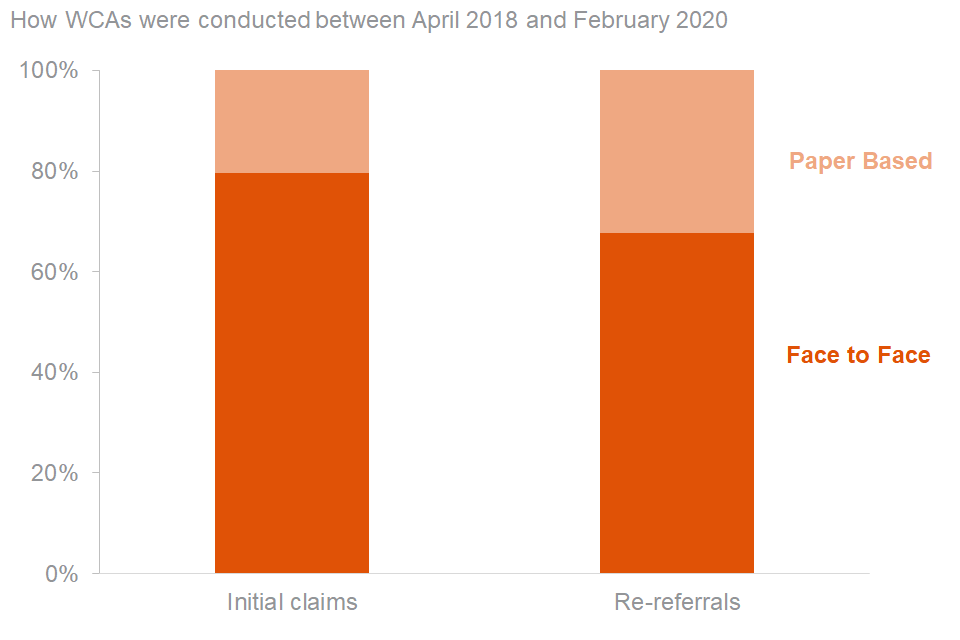
Source: Shaping Future Support Green Paper evidence pack
26% of ESA WCA recommendations are made without a face-to-face assessment.
On average between April 2018 and February 2020, 80% of ESA initial WCAs were conducted face-to-face. The remaining 20% were awarded ESA on the basis of their paper based evidence alone.
On average in this time, 68% of ESA repeat WCAs were conducted face-to-face with 32% awarded using paper based evidence.
Repeat WCAs are more likely to be conducted using paper based evidence than initial WCAs, as these cases have existing evidence of a health condition that affects the amount of work that a person can do from a previous WCA.
Proportion of PIP assessments that were completed face-to-face, paper-based or under SRTI, April 2018 to February 2020

Source: Shaping Future Support Green Paper evidence pack
16% of PIP assessments are completed without a face-to-face assessment.
On average between Apr 18 and February 20, 84% of PIP assessments were completed face to face, while 12% were paper-based and 4% were completed under special rules for terminal illness (SRTI).
This includes all PIP assessment types, including PIP new claims, DLA reassessments, Award Reviews and Changes of Circumstances.
9. The majority of people assessed via telephone during the coronavirus pandemic were satisfied
Overall satisfaction with WCA telephone assessments
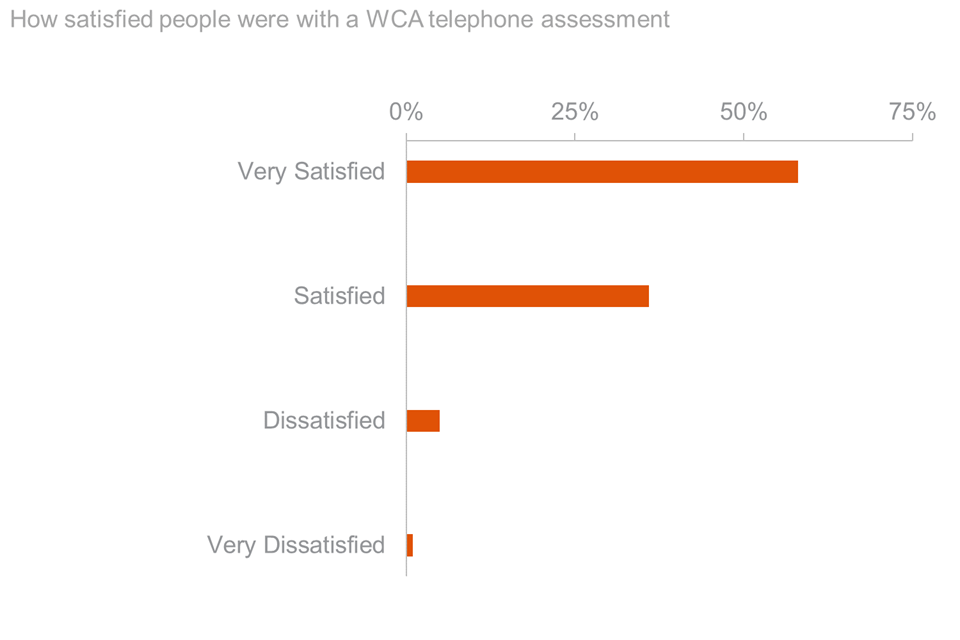
Source: Claimant experience of telephone-based health assessments for PIP, ESA and UC
94% of people undergoing a WCA were satisfied with how telephone assessments were conducted.
Following the restrictions required due to the coronavirus pandemic, face-to-face health and disability benefit assessments were suspended and replaced with telephone assessments. In a survey of 837 people assessed for PIP and 1146 people having a WCA on ESA or UC who took part in a telephone assessment, respondents were asked about their experience and their preferences for using telephone, face-to-face or video for assessment on an ongoing basis.
94% of people who underwent a telephone WCA were satisfied or very satisfied with how the assessment was conducted. Satisfaction was higher among those placed in the LCWRA group (compared to those who were added to a group awaiting a face-to-face assessment). Those who were not satisfied tended to have complaints about the assessor’s behaviour, having insufficient time to answer the questions or not feeling that the questions were tailored to their condition.
62% of people assessed in a WCA expressed a preference for telephone assessments, 23% preferred face to face and 15% expressed no preference. When adding video to possible channel preference, 13% of people assessed in a WCA said they would prefer video to face-to-face or telephone.
Overall satisfaction with PIP telephone assessments

Source: Claimant experience of telephone-based health assessments for PIP, ESA and UC
75% of people assessed for PIP on the telephone were satisfied with how telephone assessments were conducted.
Three quarters of people being assessed for PIP (75%) were satisfied or very satisfied with how the telephone assessment was conducted. Satisfaction was higher among those awarded PIP and those with unknown outcome than those who were disallowed. Issues with the assessor’s behaviour (such as not appearing to listen, understand or care about the person’s condition) was the most common reason for being dissatisfied.
When asked to choose between telephone-based and face-to-face assessments 45% of people expressed a preference for telephone-based assessments, 42% favoured face to face and 13% had no preference. When adding video to possible channel preference, 15% of people assessed for PIP said they would prefer video to face to face or telephone.
10. The Severe Conditions criteria have led to 120,000 people on ESA no longer needing routine repeat WCAs
ESA Caseload that have been assessed and met the Severe Conditions criteria
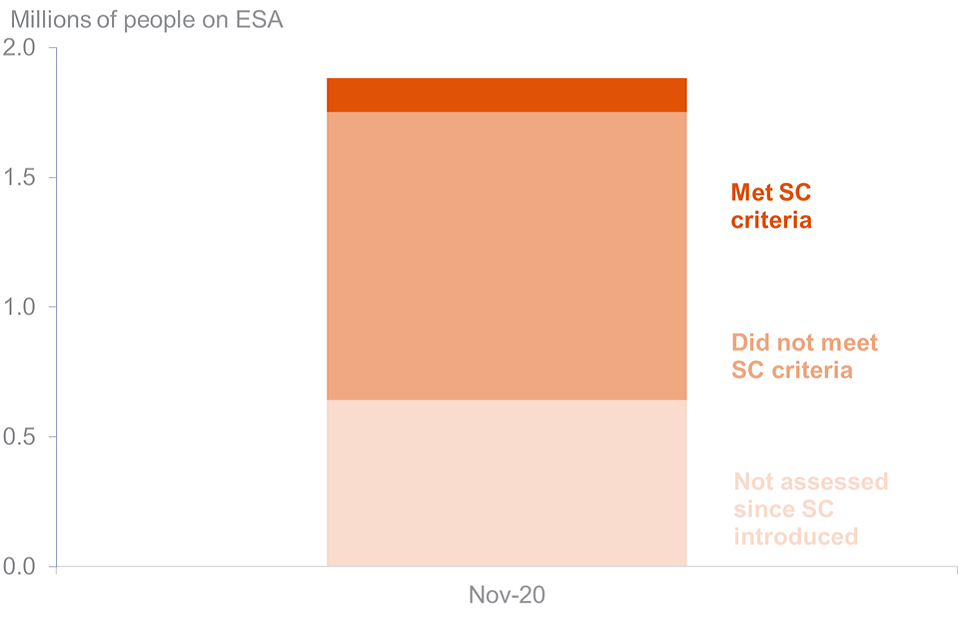
Source: Shaping Future Support Green Paper evidence pack
10% of people currently receiving ESA, and who have been assessed since the criteria were introduced, have met the Severe Conditions criteria.
People in the ESA Support Group and people on UC with limited capability for work and work-related activity (LCWRA) who had a WCA from 29 September 2017 will no longer need routine repeat WCAs if that assessment finds that they:
-
have a severe, lifelong disability, illness or health condition and
-
are unlikely to ever be able to move into work
This is referred to as the Severe Conditions criteria. People who have been assessed since September 2017 have been told if they meet these criteria they will no longer be required to attend routine repeat WCAs.
In November 2020, 130,000 people receiving ESA had met the Severe Conditions criteria. 1,240,000 people receiving ESA had been assessed since the introduction of the criteria. Therefore 10% of people receiving ESA who have been assessed since the introduction of the criteria will no longer need routine repeat WCAs.
643,000 people already receiving ESA in May 2020 had not yet been assessed since the introduction of the Severe Conditions criteria.
Volume of ESA WCAs that meet the Severe Conditions criteria
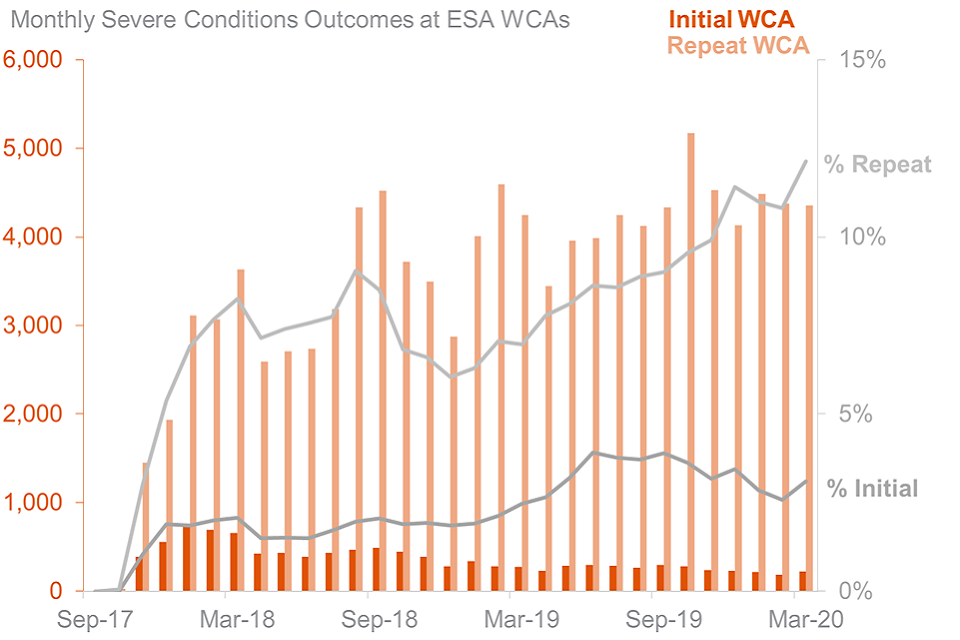
Source: Stat-Xplore
120,000 people have met the Severe Conditions criteria at ESA WCAs up to by March 2020.
Following their introduction in September 2017, 2% of all ESA initial WCAs have met the Severe Conditions criteria. 7% of all repeat ESA WCAs have also met the criteria.
Initial ESA assessments, when compared to ESA repeats, show a smaller proportion of assessments meeting the Severe Conditions criteria. This is expected as individuals going through an initial WCA are not already receiving ESA for a functionally limiting condition.
11. Award reviews or repeat assessments lead to increases and decreases in benefit entitlement
ESA Work Capability Assessment Award changes
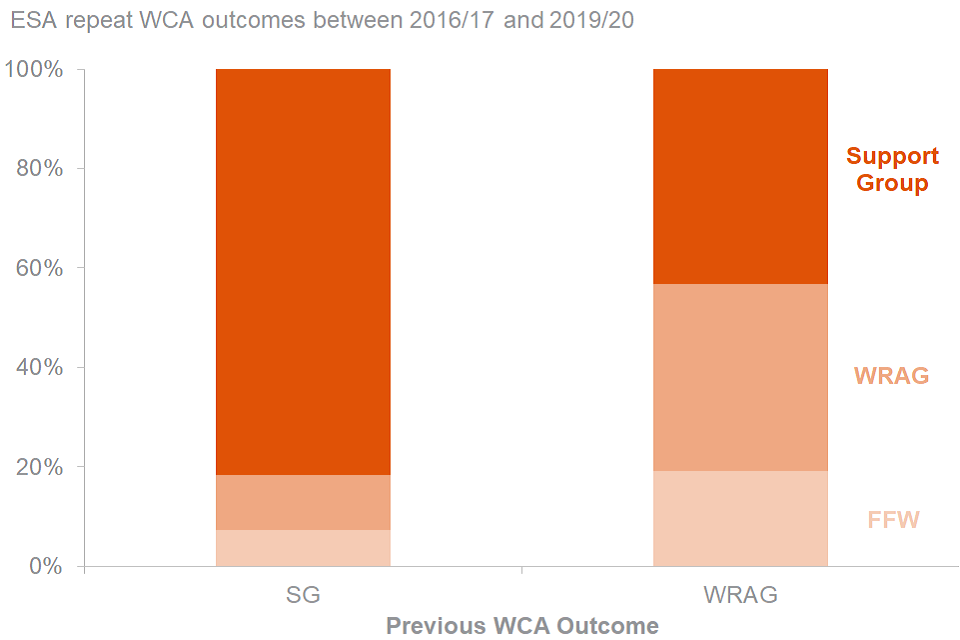
Source: Shaping Future Support Green Paper evidence pack
However, the majority of ESA Support Group repeat WCAs do not change the award.
Between 2016 and 2020, 82% of ESA repeat WCAs for people in the Support Group (SG) resulted in a decision not to change the benefit award, while 11% of these assessments resulted in Work Related Activity Group (WRAG) decisions and 7% resulted in fit for work decisions.
38% of ESA repeat WCAs for people in the WRAG did not change the benefit award. More WRAG reassessments resulted in SG decisions, 43%, than fit for work decisions, 19%.
Over this time there have been over 1.4 million ESA repeat WCAs for people in the SG, compared to 0.6 million for people in the WRAG.
PIP Award Review (including Change of Circumstances) outcomes
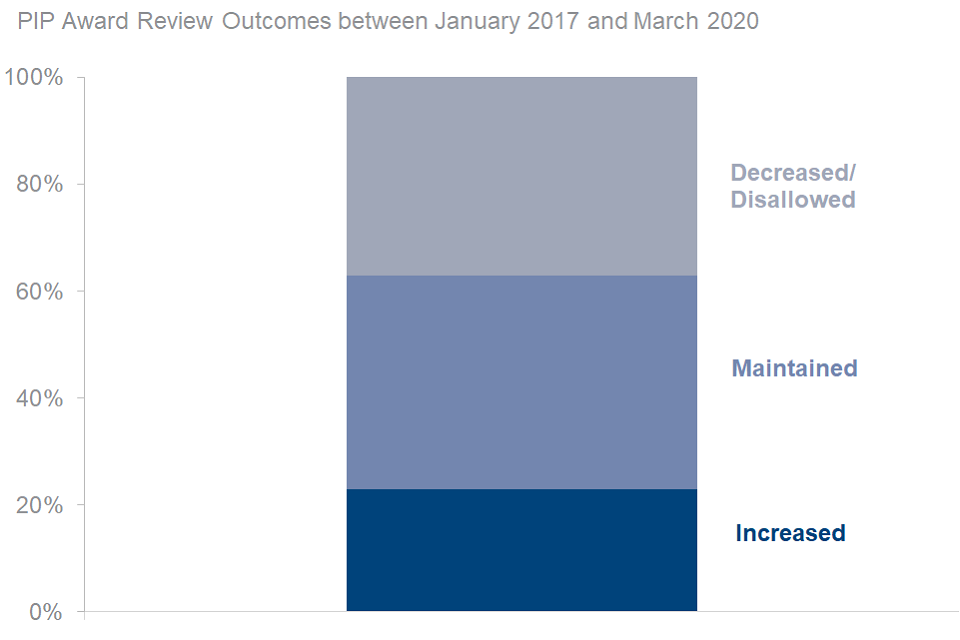
Source: Personal Independence Payment statistics to April 2021
The majority of PIP award reviews change the award, with most award changes being a reduction in award or a disallowance.
There are 8 possible rates of award on PIP. At an award review, people can change between these awards, or be disallowed PIP.
Between January 2017 and March 2020 there were over 0.8 million PIP award review clearances.
Of these review clearances, 40% maintained the PIP award at the same rate, 23% increased the PIP award to a higher rate, and the remaining 37% decreased the PIP award to a lower rate or were disallowed PIP. This includes changes of circumstances clearances, where an individual can request an assessment due to feeling that their condition has changed.
12. DWP is taking a different approach to making decisions to try and improve Decision Making
PIP Mandatory Reconsiderations decisions and percentage of awards that were changed

Source: Stat-Xplore
The proportion of PIP Mandatory Reconsideration decisions that have changed awards has increased since 2014.
Since 2019 DWP has adopted a different approach to making decisions. This has involved giving Decision Makers extra time if they need it, allowing them to gather further evidence, and encouraging them to listen to and understand the person making the claim.
The proportion of total PIP MR decisions leading to a change in award has varied over time. Withdrawals and cancellations are not included.
In January 2019, 23% of PIP MR decisions resulted in a change in award. In March 2020 the proportion of MR decisions leading to a change in award had increased to 44%.
PIP initial decision Mandatory Reconsideration where an appeal is lodged

Source: Shaping Future Support Green Paper evidence pack
The proportion of PIP MR decisions where the claimant goes on to lodge an appeal has decreased in 2019.
The percentage of MR decisions following PIP initial assessments that result in an appeal reduced in 2019. This does not include MRs and appeals relating to decisions made prior to an assessment being completed or relating to Award Review or Change of Circumstance.
The proportion of MR decisions following PIP initial assessments where the claimant lodged an appeal increased from 32% in January 2014 to 48% in June 2017. In March 2020, this proportion had decreased to 31%.
13. Important terms and abbreviations
Terms and abbreviations used throughout this publication
Caseload
The number of people receiving a benefit.
Claim
A request for a benefit.
Disabled people
People with a disability or long-term health condition.
DLA
Disability Living Allowance, which is being replaced by PIP and helps with the extra costs associated with long-term ill-health or a disability.
ESA
Employment and Support Allowance, which people can apply for if they have long-term ill-health or disability that affects their ability to work.
IS
Income Support, which is extra money to help people on a low income or none. You can no longer make a new claim for Income Support. If you’re on a low income and need help to cover your living costs, you can apply for Universal Credit instead.
JCP
Jobcentre Plus, which provide services to some people who require financial assistance.
JSA
Jobseeker’s Allowance, which is an unemployment benefit people can claim while they look for work.
LCW
Limited Capability for Work, a group on UC where you are not expected to look for work right away.
LCWRA
Limited Capability for Work and Related Activity, a group on UC you are not expected to look for work or to prepare for work.
PIP
Personal Independence Payment, which can help people with some of the extra costs associated with long-term ill-health or a disability.
PSP
Personal Support Package, which offers tailored support for people in the ESA WRAG or Universal Credit LCW group.
SG
Support Group, a group on ESA for people who are assessed as not able to get back into work.
SRTI
Special Rules for Terminal Illness, if a person is living with a terminal illness and a doctor or a medical professional has said they might have less than 6 months to live, they may get benefits at a higher rate or get extra money and start getting payments quicker than usual.
TI
Terminal Illness, a health condition that a person will most likely die from.
UC
Universal Credit, which is a payment to help with living costs. It is replacing 6 other benefits. These are:
- Child Tax Credit
- Housing Benefit
- Income Support
- income-based Jobseeker’s Allowance (JSA)
- income-related Employment and Support Allowance (ESA)
- Working Tax Credit
UC*
People on Universal Credit (UC) who have had medical evidence checked as they have a restricted ability to work, or are assessed as LCW or LCWRA.
WCA
Work Capability Assessment, a functional assessment of a person’s fitness to work.
WHP
Work and Health Programme, personal support to help people find and keep a job if they are out of work.
WRAG
Work Related Activity Group, a group on ESA for people who are assessed as able to get back into work in the future.
Definition of medical conditions
ICD Group refers to the World Health Organisations’ International Classification of Diseases (2010) Condition Groups. These are sometimes referred to as medical conditions in DWP statistics. For reporting purposes, the conditions as recorded on DWP systems have been mapped to reflect as closely as possible the appropriate ICD10 code. Conditions are based on evidence provided and may not represent a person’s most recent medical condition. Where someone has more than one diagnosis or disabling condition, only the predominant one is reported on in these statistics.
The following abbreviations are used in these statistics.
| Abbreviation used in these statistics | ICD10 Description |
|---|---|
| Infectious Diseases | Certain Infectious and Parasitic Diseases (A00 - B99) |
| Neoplasms | Neoplasms (C00 - D48) |
| Blood/Immune System Diseases | Diseases of the Blood and Blood forming organs and certain diseases involving the immune mechanism (D50 - D89) |
| Metabolic Diseases | Endocrine, Nutritional and Metabolic Diseases (E00 - E90) |
| Mental/Behavioural Disorders | Mental and Behavioural Disorders (F00 - F99) |
| Nervous System Diseases | Diseases of the Nervous System (G00 - G99) |
| Visual Impairment | Diseases of the Eye and Adnexa (H00 - H59) |
| Hearing Impairment | Diseases of the Ear and Mastoid Process (H60 - H95) |
| Circulatory Diseases | Diseases of the Circulatory System (I00 - I99) |
| Respiratory Diseases | Diseases of the Respiratory System (J00 - J99) |
| Digestive Diseases | Diseases of the Digestive System (K00 - K93) |
| Skin Diseases | Diseases of the Skin and Subcutaneous System (L00 - L99) |
| Musculoskeletal Diseases | Diseases of the Musculoskeletal system and Connective Tissue (M00 - M99) |
| Genitourinary Diseases | Diseases of the Genitourinary System (N00 - N99) |
| Pregnancy | Pregnancy, Childbirth and the Puerperium (O00 - O99) |
| Perinatal conditions | Certain conditions originating in the perinatal period (P00-P96) |
| Congenital conditions | Congenital Malformations, Deformations and Chromosomal Abnormalities (Q00 - Q99) |
| Not classified elsewhere | Symptoms, Signs and Abnormal Clinical and Laboratory findings, not elsewhere classified (R00 - R99) |
| External causes | Injury, Poisoning and certain other consequences of external causes (S00 - T98) |
| External causes | External causes of morbidity and mortality (V01-Y98) |
| Health Services | Factors influencing health status and contact with health services (Z00 - Z99) |
| Unknown | Unknown or person without diagnosis on the system |
